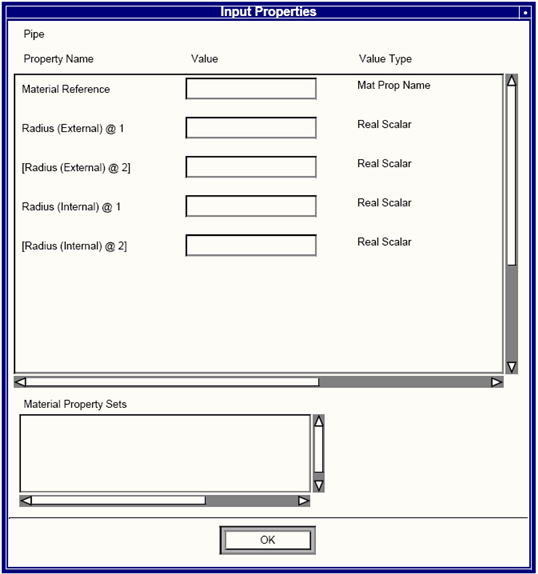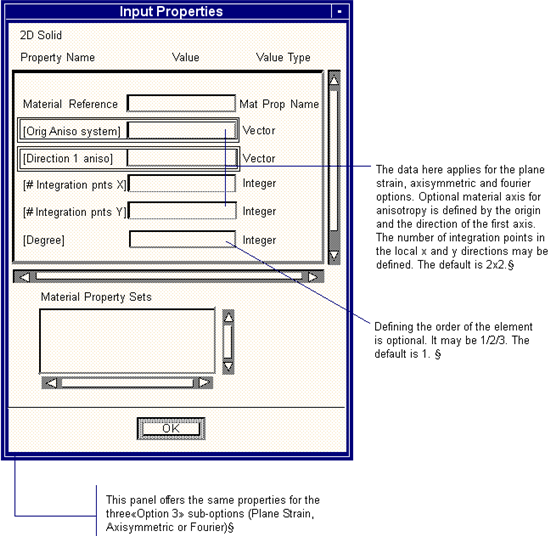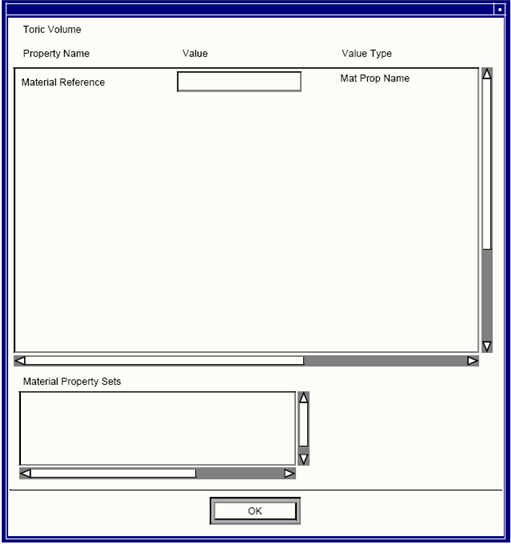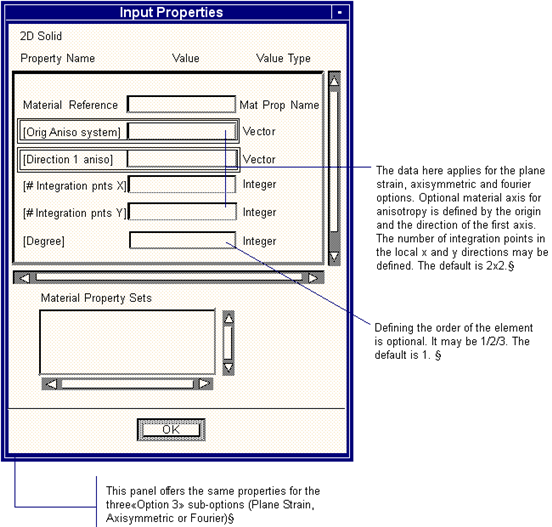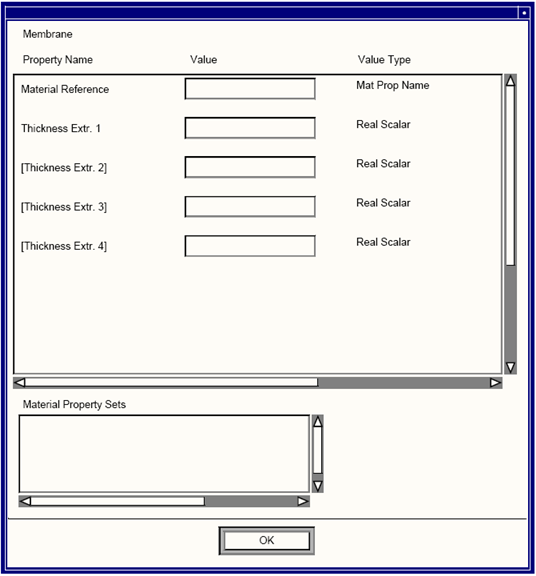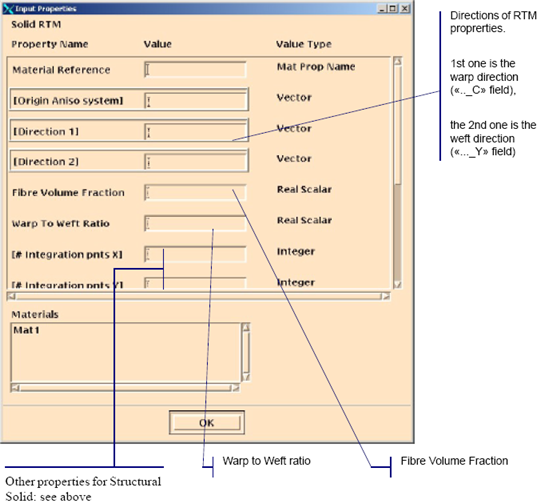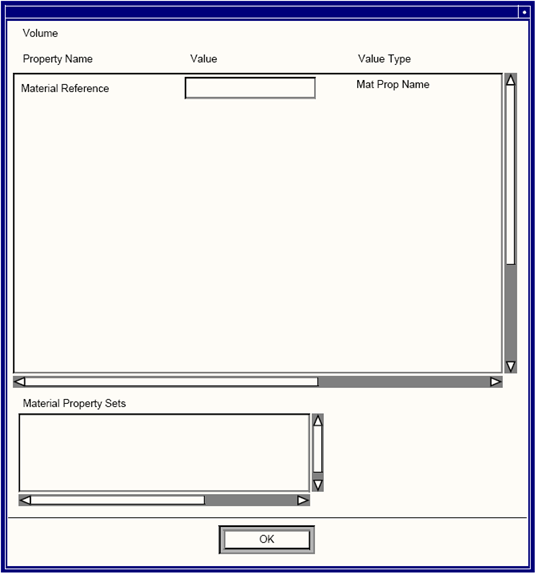XXXXXXXXXXXXXXXXXXXXXXXXXXXXXXXXXXXXXXXXXXXXXXXXXXXXXXXXXXXXXXXXXXXXXXXXXXXXXXXXXXXXXXXXXXXXXXXXXXXXXXXXXXXXXXXXXXXXXXXXXXXXXXXXXXXXXXXXXXXXXXXXXXXXXXXX''"> Element Properties
By choosing the Element Properties toggle located on the main menu in MSC Patran, the Element Properties form will appear. When creating element properties, several option menus are available. The selections made in these option menus will determine which element property form is presented, and ultimately, which SAMCEF element will be created.
The following pages give an introduction to the Element Properties form, followed by the details of all the element property definitions supported by the MSC Patran SAMCEF Preference Guide.
Element Properties Form
When Element Properties is selected on the main menu, the following form will be displayed. Four option menus on this form are used to determine which SAMCEF element types are to be created, and which property forms are to be displayed. The individual property forms are documented later in this section. For more details, see the
Create Element Property Sets (p. 62) in the Patran Reference Manual.
The following table shows the allowable selections for all option menus when Analysis Type is set to Structural.
Object | Option 1 | Option 2 | Option 3 |
0D | | | |
| General Section Pipe Section | |
1D | | General Section
Pipe Section | Mindlin
Plane
3D Memb. |
| General
Linear
Non Linear | |
| Axisymmetric
Fourier | |
| General Section
Pipe Section | Mindlin
Mindlin |
| Plane Strain
Axisymmetric
Fourier Membrane | |
2D | | Mindlin | |
| Plane Strain
Axisymmetric
Fourier
Fourier Membrane | |
| Plane
3D Membrane | |
3D | | Homogeneous | |
| Homogeneous
RTM | |
The following table shows the allowable selections for all option menus when Analysis Type is set
to Thermal
Object | Option 1 | Option 2 | Option 3 |
1D | • Rod | | |
• Axisymmetric Membrane | | |
• Pipe | | |
2D | • Shell | | |
• 2D Solid | | |
• Membrane | | |
3D | • Solid | | |
Important: | The following pages will detail the most major Element Properties forms and
sub-forms... but not all. |
(0D)Mass (Structural only)
Options below create a concentrated mass that is associated with the degrees‑of‑freedom of a node. This creates a concentrated mass at a point which results in generation of the .MASS command.
(0D)-Axisymmetric Bar (Structural only)
This form creates axisymmetric bar element properties.
(pipe section option view)
(1D)Rod (Structural & Thermal)
Options below create 1D rod element properties for Structural analysis..
(pipe-section option)
Options below create 1D rod element properties for Thermal analysis.
(1D)Spring (Structural only)
Options below create spring properties. Springs may be general, linear or nonlinear.
(linear option view)
(non linear spring view)
(1D)Axisymmetric Shell, Fourier Membrane (Structural only)
Options below create axisymmetric shell element properties. Elements may be of true axisymmetric
or Fourier.
Note: | The MKU and MKP (second order stiffness matrix due to large rotation and second order stiffness due to active pressure) options may be selected for second order elements. The default is “NO.” |
(1D)Beam (Structural only)
Options below create a 3D beam element of general or pipe section..
Note: | The MKU and MKP (second order stiffness matrix due to large rotation and second order stiffness due to active pressure) options may be selected for second order elements. The default is “NO.” |
(1D)Axisymmetric Membrane (Structural & Thermal)
Options below create 1D axisymmetric membrane element properties for Structural analysis. Elements may be plane strain or axisymmetric.
Options below create 1D axisymmetric membrane element properties for Thermal analysis
(1D) Pipe (Thermal only)
(2D)Shell (Structural & Thermal)
Options below create a thin shell element for a Structural analysis.
.
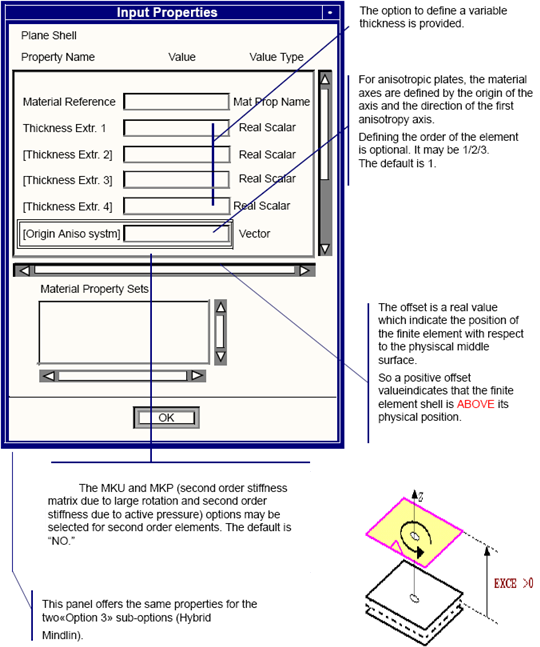
Options below create a thin shell element for a Thermal analysis
(2D) 2D Solid (Structural & Thermal)
Options below create a 2D solid element for a Structural analysis.
The element may be of plain strain, axisymmetric or Fourier.
Note: | The MKP (second order stiffness matrix due to active pressure) options may be selected for second order elements. The default is “NO.” |
Options below create a 2D solid element for a Thermal analysis.
(2D) Membrane (Structural & Thermal)
Options below create a membrane element for a Structural analysis.
The element may be either plane or 3D.
Note: | The MKP (second order stiffness matrix due to active pressure) options may be selected for second order elements. The default is “NO.” |
Options below create a membrane element for a Thermal analysis
(3D) Thick Shell (Structural only)
Options above create thick shell elements, which may have wedge or hexahedral topologies.
Note: | The MKU and MKP (second order stiffness matrix due to large rotation and second order stiffness due to active pressure) options may be selected for second order elements. The default is “NO.” |
(3D) Solid Structural (Homogeneous)
Options below create solid elements for a Structural analysis, homogeneous option, which may have tetrahedral wedge or hexahedral topologies.
Note: | The MKU and MKP (second order stiffness matrix due to large rotation and second order stiffness due to active pressure) options may be selected for second order elements. The default is “NO.” |
(3D) Solid (RTM)
Options below create solid elements for a Structural analysis, RTM options, which may have tetrahedral wedge or hexahedral topologies.
(3D) SolidThermal)
Options below create solid elements for a Thermal analysis
















